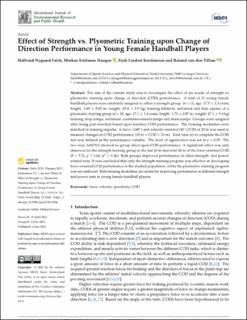| dc.contributor.author | Falch, Hallvard Nygaard | |
| dc.contributor.author | Haugen, Markus Estifanos | |
| dc.contributor.author | Kristiansen, Eirik Lindset | |
| dc.contributor.author | van den Tillaar, Roland Johannes Wilhelmus | |
| dc.date.accessioned | 2023-02-07T14:54:55Z | |
| dc.date.available | 2023-02-07T14:54:55Z | |
| dc.date.created | 2022-09-12T08:39:16Z | |
| dc.date.issued | 2022 | |
| dc.identifier.citation | Falch, H. N., Haugen, M. E., Kristiansen, E. L. & van den Tillaar, R. (2022). Effect of strength vs. plyometric training upon change of direction performance in young female handball players. International Journal of Environmental Research and Public Health, 19(11), Article 6946. doi: | en_US |
| dc.identifier.issn | 1660-4601 | |
| dc.identifier.uri | https://hdl.handle.net/11250/3048969 | |
| dc.description.abstract | The aim of the current study was to investigate the effect of six weeks of strength vs. plyometric training upon change of direction (COD) performance. A total of 21 young female handball players were randomly assigned to either a strength group: (n = 11, age: 17.5 ± 2.3 years, height: 1.69 ± 0.05 m, weight: 65.8 ± 5.9 kg) training bilateral, unilateral and later squats; or a plyometric training group (n = 10, age: 17.1 ± 2.4 years, height: 1.73 ± 0.07 m, weight: 67.1 ± 9.3 kg) training drop jumps, unilateral countermovement jumps and skate-jumps. Groups were assigned after being pair-matched based upon baseline COD performance. The training modalities were matched in training impulse. A force- (180°) and velocity-oriented (45°) COD of 20 m was used to measure changes in COD performance (10 m + COD + 10 m). Total time (s) to complete the COD test was defined as the performance variable. The level of significance was set at p < 0.05. The two-way ANOVA showed no group effect upon COD performance. A significant effect was only observed for the strength training group in the last 10 m and total 20 m of the force-oriented COD (F ≥ 5.51; p ≤ 0.04; η2 ≥ 0.36). Both groups improved performance in other strength- and power-related tests. It was concluded that only the strength training program was effective in developing force-oriented COD performance in the studied population, while the plyometric training program was not sufficient. Both training modalities are useful for improving performance in different strength and power tests in young female handball players. | en_US |
| dc.language.iso | eng | en_US |
| dc.publisher | MDPI | en_US |
| dc.rights | Navngivelse 4.0 Internasjonal | * |
| dc.rights.uri | http://creativecommons.org/licenses/by/4.0/deed.no | * |
| dc.title | Effect of strength vs. plyometric training upon change of direction performance in young female handball players | en_US |
| dc.type | Peer reviewed | en_US |
| dc.type | Journal article | en_US |
| dc.description.version | publishedVersion | en_US |
| dc.rights.holder | © 2022 The Authors | en_US |
| dc.source.pagenumber | 16 | en_US |
| dc.source.volume | 19 | en_US |
| dc.source.journal | International Journal of Environmental Research and Public Health (IJERPH) | en_US |
| dc.source.issue | 11 | en_US |
| dc.identifier.doi | 10.3390/ijerph19116946 | |
| dc.identifier.cristin | 2050554 | |
| dc.source.articlenumber | 6946 | en_US |

